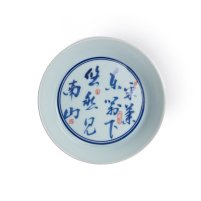Hand wash with warm water and liquid detergent as necessary.
Blue White
Hu Cheng Tray
Jingdezhen
SKU
6033
Pale blue porcelain tea tray adorned with poetic Chinese calligraphy, handcrafted in Jingdezhen, the legendary "porcelain capital" of China. This Hu Cheng is decorated in the classic blue and white Qinghua style and is used to support a teapot or Gaiwan, as well as cups or teatime treats.
| Product | Hu Cheng tea tray |
| Origin | Jingdezhen, Jiangxi, China |
| Dimensions | Ø14cm x 2.8cm |
| Weight | 630g |
| Material | Porcelain |
| Decoration | 采菊東籬下,悠然見南山。
While picking asters 'neath the eastern fence, |
In stock















